All About Of Pavement Markings | What Is Pavement Marking | Types of Pavement Marking and Their Meaning
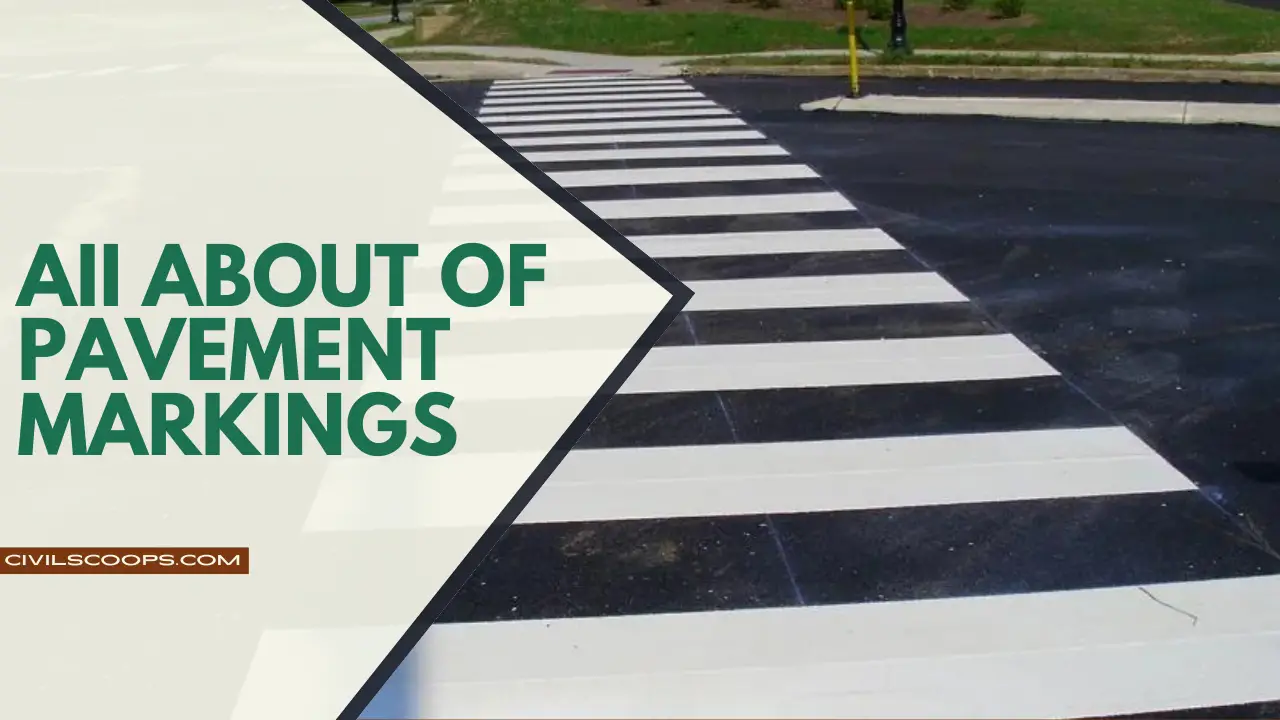
Table of Contents
Introduction of Pavement Markings
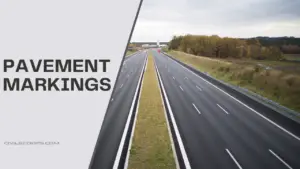
For road users, road marking or pavement marking is a component of an intelligence system as a road signal and signs. The pavement marking system helps the drivers for understanding the location and upcoming situation, and where and how to arrange the vehicles.
For the marking of the pavement, many colors can be used, but in the roadway, two colors are mostly used, that is yellow and white because these two colors are most visible in all weather conditions.
What Is Pavement Marking?
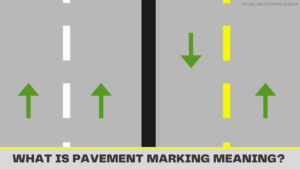
Pavement marking is an information and guidance process that is provided by marking the roadway for the drivers and pedestrians. For the other facilities like marking the parking area for the vehicles, this system is used.
When you see yellow or white color lines have marked the center of the road or with the colors dividing travel lanes, then you have to understand that, the traffic is traveling in two or one direction.
In these colors, the white color is used for traffic lanes moving in the same direction, and the yellow color is used for, the traffic moving in the opposite direction. In the roadway striping, the pavement roadway is exclusive.
The pavement marking is generally used to, optimize roadway capacity, orderly traffic flow, and inspire safe drive. For providing good nighttime and daytime visibility, all pavement should be maintained accurately. When the pavement marking installation is decided by the municipality, then they must maintain it.
But when the municipality decides that, it no longer needed the marking, then the selection process for the documentation should be recorded.
Types of Pavement Marking
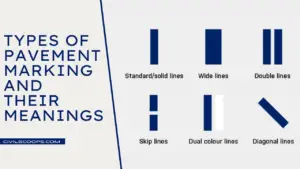
There are have many types of pavement marking and their meaning, which is described below-
- Longitudinal Pavement Marking.
- Yellow Pavement Marking.
- No-Passing Zones.
- White Lane Line Pavement Marking.
- Edge Line Pavement Marking.
- Raised Pavement Marking.
- Stop and Yield Lines.
- Crosswalk Pavement Marking.
- Roundabout Pavement Marking.
1. Longitudinal Pavement Marking
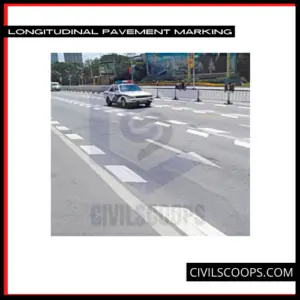
The longitudinal pavement marking are marked adjoining and parallel to lane lines, traffic flow, edge lines, centerline, channelizing line, etc.
The longitudinal pavement marking lines are drawn as a broken yellow line, solid yellow line, double solid yellow line, solid white line, double solid white line, broken white line, and dotted white line.
The longitudinal pavement marking is one of the best and most used pavement marking in the world. On the travel lane, by providing the visual solution, and on the roadway, markings guide the traffic.
There are many functions of the longitudinal lines like the function of a double line is major or maximum restrictions, and the function of a solid line is, depends on the operation prohibits or stops crossing, a broken line is permitting condition, and also the function of a dotted line is provide warning or advice ahead route function variations.
The arrangement width of the longitudinal line is, a double line is arranged as a double separated parallel line, the dotted line is arranged as a shorter line of 2 feet to 6 feet gaps, and the line section is 2 feet and in the intersection, it is used, another hand in the lane line it is used as a 9 feet gap and also 3 feet line section, and the broken line is drawn as a 30 feet gaps and 10 feet normal line section.
And the width of the longitudinal lines is, a normal line in the longitudinal marking is, 4 to 6 inches broad and the wide line is double the width of the normal line.
When we need to change or cross the lanes, then by yellow or white broken lines this function is enabled.
2. Yellow Pavement Marking

The yellow pavement marking lines are used, when we need to create double lanes on the same road. It’s drawn in the center of the road perfectly.
The yellow broken lines allow passing the vehicle on the road, but the two yellow lines like broken or solid, do not provide permission for passing the vehicle on the road near the solid line.
For four or more traffic lanes, in the undivided two-way roadways no passing zone marking and in the two directions, the centerline will be marked.
The types of lines drawn indicate the traffic rules set by the local authority. If the line is broken or dotted with line fragments then that indicates that it is allowed to pass but passing should be taken place carefully.
If the pavement is done with two lines, one undivided and one divided line then that indicates that while going along with the undivided line passing is prohibited but while going along the divided line passing is allowed. The double solid undivided yellow line indicates that passing is prohibited.
3. No Passing Zone
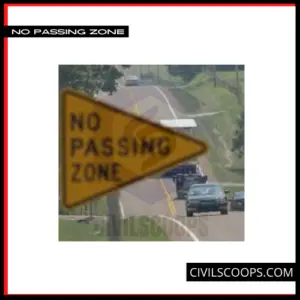
On two or three-way roadways no passing zones are usually made. They are very essential to decrease the possibility of accidents. The no passing is created with undivided marking in the middle of the road.
In one direction no-passing zone pavement markings, two lines are drawn of which one is divided and another is not divided. This indicates no passing zone. The side adjacent to the solid line indicates the prohibition of passing for the traffic on the lane. On the other side where the line is divided, passing is allowed.
In two-direction no passing pavement markings two lines are drawn in the middle of the road. Both the lines are single undivided solid lines and they indicate the prohibition of passing on both sides.
For no passing pavement markings, some places are considered common places that must need no passing zone. These areas are grade crossings, highway-rail grade crossings, lane deduction transitions, and locations where sight distance is not adequate.
4. White Line Pavement Markings
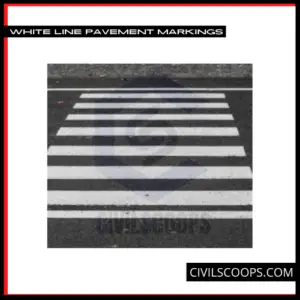
White line pavement markings are done on the same road which indicates the same direction of driving. On roads where traffic moves in the same direction, two and more adjoining lanes are created to distinguish between the two different lanes where traffic moves in the same direction.
White pavement lines are done on roads that have enough breadth to hold more than one lane that consists of traffic moving in the same direction. In crowded or overcrowded locations like markets etc. White pavement is done. Lanes which are marked with white pavement are usually less crowded than the lanes without any pavement.
White pavement lines are also of two different types. One drawn with a broken line and another done with an undivided or unbroken solid white line. Each of these indicates the traffic rule and regulations applied by the local authority.
If the pavement is done with a broken line that refers the driver or traveler can change the lane accordingly. And if the pavement is done with an unbroken solid line then that means changing the lanes is prohibited.
5. Pavement on the Edge of the Road
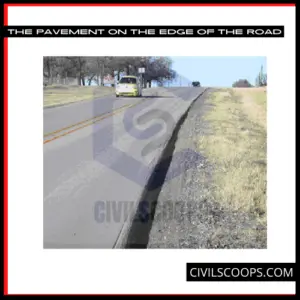
The pavement done on the edge of a road is called edge line pavement markings. These lines can be seen on both edges of the road. To make the edge of the road visible this type of pavement is done. In times like adverse weather, rain, or storm these lines appear to the driver which prevents accidents from happening.
There are universal rules relating to the pavement done on the edge of the road. An undivided white line is used to define the rightmost side of a road while a yellow undivided line indicates the left side of the road.
Extending the lines through interaction is not done while doing the pavement.
6. Raised Pavement Markings

Pavements, where reflective or nonreflective cubical shaped tools are used alongside markings, are called raised pavement markings.
In raised pavement marking mostly retroreflective prismatic cubes are used but non-retro-reflective materials can be used too.
A road with raised pavements that reflects the headlight of a car at the night prevents cars or bikes from losing sight of the road. And in adverse weather like rain, this type of pavement help too. Also raised pavements, if done with good quality material make the road appear beautiful. Raised pavements work better than markings.
7. Stop and Yield Lines
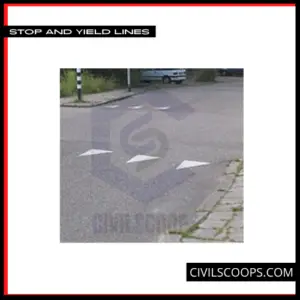
Stop and yield lines are the type of transversal pavements. Across the road transversely this pavement is done with white color paint. Before a mid-walk at an intersection of roads stop and yield lines are drawn.
Stop and yield lines tell drivers to stop the car or yield before reaching a mid-walk and intersection. Stop and yield markings are perpendicular to the lane it is drawn on.
A perpendicular line is drawn to the lane across the road and isosceles triangles are drawn along with it. The shape looks like a horizontally spiked zig-zag-like shape. Against the traffic. The color of the entire marking is white.
8. Crosswalk Pavement Markings
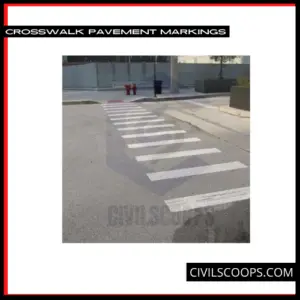
As appeared by the name crosswalk pavement markings are pavement markings done for the pedestrians keeping in mind that while crossing a road many accidents happen.
Places like schools, crossings, traffic signals, etc are such places where crosswalks can be seen. These crosswalk markings are very helpful to pedestrians and they lessen the probability of accidents.
In the place where two or more roads intersect or cross each other, crosswalks exist. When the traffic stops at the intersection, pedestrians can cross the road through the crosswalks.
Places where usually crosswalks are used as school walking roads, uncontrolled crossings of certain types, signalized intersections, etc are most suitable for crosswalks.
9. Round about Pavements

An intersection of four roads that creates a round-shaped area is the place where the roundabout pavement is done. The main objective of the roundabout pavement is to facilitate traffic control and help avoid the chaos of traffic.
The roundabout pavement marking’s signing and markings are designed integrally keeping in mind the use and directions of the roundabout and the geometric shape of the roundabout.
Different Colours Used in Pavement Markings and Their Uses-
Different colored pavements have different uses and the color of the pavement is something that indicates the rules and regulations of the location.
This colored code is used universally. That means in your country a divided yellow line and a divided yellow line in another country carry the same meaning. Here are some colors and their codes are given below.
- Yellow: yellow-colored pavements have an integral role in traffic maintaining. The yellow-colored line at the center of a road or highway divides the road into two separate lanes. These two separate lanes have different directions of traffic flow. They divine the left edge of the highway and one-way roads. They distinguish between reversible and irreversible roads.
- White: white-colored pavements divide a road into different lanes of traffic flow in the same direction. They indicate the rightmost edge of a road.
- Blue: white markings could be supplemented by blue markings. For handicaps parking, it is used.
- Purple: approaching lane lines of toll plaza could be supplemented by the purple-colored pavement lines.
- Black: With white, blue, red, purple, and yellow-colored pavement black color is used. The black color gives contrast to the light color in case the color is not visible.
Pavement Marking Material
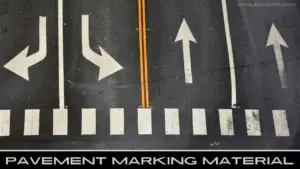
Pavement markings indicate the rules and regulations of traffic control in any place. So the color of the pavement markings, size, and pattern used in pavement markings are essential. For durable long-lasting pavements, many materials are used. Some type of material absorbs heat and glows in the dark giving a sight of the road.
In some cases cubic shaped prismatic textured material is used for pavement. As pavements usually advise the travelers how to travel in different places accordingly. The advice must be positive so regulated standards should be followed while making the pavements.
Some essential materials used in pavement making are such as thermoplastic, and paint, which are common, and other than those raised pavement markers, colored pavements are used.
The most used material is paint. Using paint in pavement marking is easier, simpler, and most importantly cheaper. Paint is an economical material but paint is not so durable. Also, paint is not visible during the nighttime. But for retroreflection quality, glass beds can be mixed with paint, and then the mixture could be used in pavement marking.
Thermoplastic is also a largely used material in pavement marking. Thermoplastic absorbs heat and utilizes the absorbed heat. But a twist is that when something gets heated it enlarges and when it gets cold it contracts. The amount of contraction and enlargement varies with different materials.
Here in the case of thermoplastic the differentials between contraction and enlargement of pavement and material used in road-making (concrete) are not the same. This results in the separation of thermoplastic from the concrete. So in concrete roads thermoplastic is unsuitable.
Advantages of Pavement Marking

There Are Have Many Types of Advantages of the Pavement Marking That Is Below-
- The advantage of pavement marking is that for the installation of the pavement marking special equipment is not required and it is easily can be installed.
- Depending on the environment of the road traffic, the life span of the pavement marking is variable, but the average lifespan of the pavement marking is about 5 to 8 years approximately.
- Another advantage of pavement marking is, that it has excellent durability and also has very good night visibility.
- The advantage of the pavement marking is, that in the road marking the colors are used, which are waterborne and cold solvents for this cost of the project is less than compared to the thermoplastic paint.
- The main advantage of pavement marking is, that in this pavement marking, the use of various types of colors for the marking reduces the possibility of an accident by increasing the visibility of the driver and also providing directions.
- And the last advantage of the pavement marking is, for this special labor and equipment are not required and it can easily be marked after normal cleaning of the road.
Disadvantages of the Pavement Marking
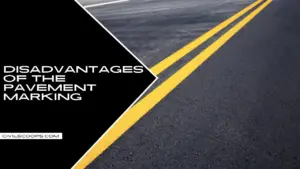
As like above advantages, the pavement marking has many types of disadvantages that are below-
- The disadvantages of the pavement marking are, that when highly durable paint is used like thermoplastic paint, then the cost of the project is increased.
- Another disadvantage of the pavement marking is, of the poor condition of the old road, it is not suitable.
Like this post? Share it with your friends!
Suggested Read –
- What Is Fresh Concrete? | Properties of Fresh Concrete | Factors Affecting Workability
- Hand Level Surveying | What Is Site Level? | What Is Hand Level? | How to Use a Hand Sight Level | Estimating Distances with a Sight Level
- Types of Cement Grades | Difference Between 33, 43 & 53 Grade Cement
- What Is Panelled Window? | What Is Glazed Window? | Difference Between Paneled Window and Glazed Window
- What Is Flyash Brick? | Fly Ash Bricks Cost | Properties of Flyash Bricks | Fly Ash Bricks Manufacturing Process | Compressive Strength of Fly Ash Brick | Fly Ash Brick Size | Advantages & Disadvantages of Fly Ash Bricks
Frequently Asked Questions (FAQ)
Yellow Pavement Markings
They indicate which part of the road to use, provide information about conditions ahead, and indicate where passing is allowed. Yellow lines separate traffic flowing in opposite directions. Drivers should stay to the right of yellow lines. A solid yellow line indicates that passing is prohibited.
Yellow Dotted Line on Road
These lines appear on stretches with bends. Crossing the yellow line is punishable. Crossing these lines are prohibited. Vehicles on the side of the broken line can cross the line to the other side.
A Broken Yellow Line on a Pavement
Broken Yellow Center Line
The combination of a solid yellow and a broken yellow centerline also shows the center of a two-way roadway. You may pass if the broken line is on your side of the road and safe conditions exist, but you may not pass when a solid yellow line is on your side of the road.
Yellow Pavement Markings on the Road Indicate
Originally posted 2022-05-30 11:27:05.
